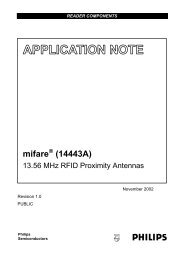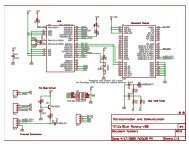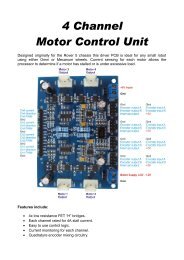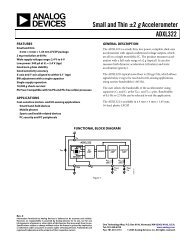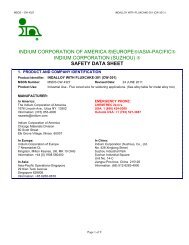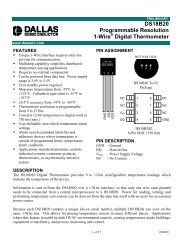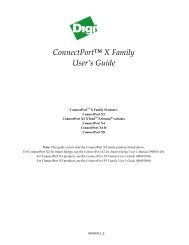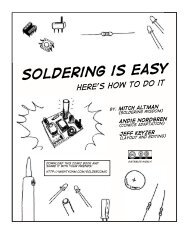SanDisk SD Card
SanDisk SD Card
SanDisk SD Card
Create successful ePaper yourself
Turn your PDF publications into a flip-book with our unique Google optimized e-Paper software.
Revision 2.2Chapter 4 – <strong>SD</strong> <strong>Card</strong> Protocol Description<strong>SanDisk</strong> <strong>SD</strong> <strong>Card</strong> Product ManualThe host drives only one card, because it is not possible to control two cards or more ifeach of them has a different timing mode (Default and High-Speed). In order to satisfysevere timing, the CLK/CMD/DAT signal will be connected one-to-one between host andcard.Maximum current consumption for <strong>SD</strong> cards operating in high-speed mode is 200mA(averaged over a period of one second). In High-speed Mode, VDD_R_CURR_MIN,VDD_W_CURR_MIN, VDD_R_CURR_MAX and VDD_W_CURR_MAX values in theC<strong>SD</strong> Register are meaningless. Also, in High-speed Mode, the TRAN_SPEED value in theC<strong>SD</strong> Register is 0_1011_010b (05Ah), which is equal to 50MHz.If necessary, the host will check the current consumption, indicated by the status returnedby the Switch Function command (CMD6).4.4.12 Command System<strong>SD</strong> <strong>Card</strong> commands CMD34-37, CMD50, CMD57 are reserved for <strong>SD</strong> command systemexpansion via the switch command. Switching between the various functions of thecommand-system function group, will change the interpretation and associated bustransaction (i.e., command without data transfer, single-block read, multiple-block write,etc.) of these commands.• When the standard command set (default function 0x0) is selected, the card will notrecognize the commands and they will be considered illegal (as defined in the <strong>SD</strong>Physical Layer Specification v1.01).• When the vendor-specific (function 0xE) is selected, the commands are vendorspecific.They are not defined by this standard and may change for different cardvendors.• When the mobile e-commerce (function 0x1) is selected, the behavior of thesecommands is governed by “Part A1: Mobile Commerce Extension Specification” of the<strong>SD</strong> <strong>Card</strong> specification.4.5 Clock ControlThe host can use the <strong>SD</strong> <strong>Card</strong> bus clock signal to set the cards to energy-saving mode orcontrol the bus data flow. The host is allowed to lower the clock frequency or shut it down.A few restrictions the host must follow include:• The bus frequency can be changed at any time under the restrictions of maximum datatransfer frequency, defined by the <strong>SD</strong> <strong>Card</strong> and the identification frequency.−An exception is an ACMD41 (<strong>SD</strong>_APP_OP_COND). After issuing commandACMD41, either of the following procedures will be completed by the host untilthe card becomes steady: 1) Issue continuous clock in frequency range of 100KHz-400 KHz, 2) If the host wants to stop the clock, the busy bit must be polledby the ACMD41 command at less than 50-msec intervals.© 2004 <strong>SanDisk</strong> Corporation 4-27 12/08/04



